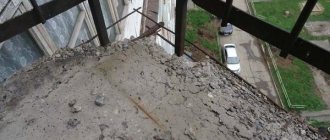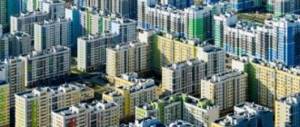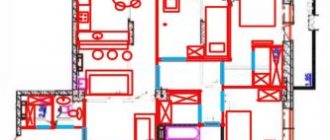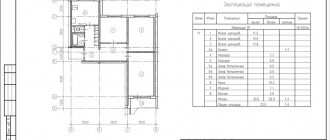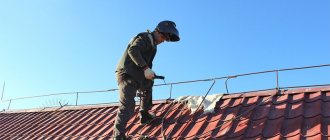Repair and decoration
04/23/2018 Anastasia Prozheva
In most apartment buildings, balconies are in poor technical condition. Most residential buildings are in poor condition; in order to avoid destruction of the building and prevent human casualties, it is necessary to promptly repair and restore damaged areas. The balconies in an apartment building are especially in poor condition, putting at risk not only the residents of the apartment itself, but also people passing nearby.
Balcony and repairs: at whose expense is it carried out?
The question of who should repair balconies in an apartment building does not have a clear answer; in some articles the housing and communal services are indicated, in others - the residents of the building or the HOA.
Load-bearing structures are repaired by housing and communal services, these include:
- Walls of a residential building;
- Foundation;
- Overlap;
- Enclosing columns and structures.
Properly carried out repair work significantly extends the life of the balcony and avoids human casualties.
Unfortunately, today the issue of repairing balconies raises a lot of controversy.
Namely:
- Strengthening the frame of a reinforced concrete slab will make it possible to turn a loggia into a small place for relaxation;
- Properly done waterproofing work will prevent the accumulation of moisture, keeping the frame and concrete dry and strong;
- Installing double-glazed windows will make the balcony warm; you can place flowers in it, creating a winter garden, and relax on a rainy day, reading or doing handicrafts.
Based on the housing code, which specifies that common places are those used by several families, the balcony is private property, so the owners must repair it in an apartment building.
Legal norms establishing the owners of various structures of an apartment building
A balcony is a cantilever-beam structure, which consists of:
- load-bearing plate;
- non-load-bearing fencing - railings.
Who, according to the law, owns these buildings? If we turn to clause 2 of the Rules for maintaining property in an apartment building dated August 13, 2006, we find out that:
The slabs of the building's balconies belong to the residents, who own the apartments as shared ownership.
- Residents who own apartments on a shared ownership basis own: slabs of all balconies of the building (since they are load-bearing enclosing structures); windows and doors located on them (if they are located in common areas); balcony railings in common areas.
- If the wall and balcony slabs, according to the technical passport issued by the BTI, belong to a residential premises, then they are the private property of the citizens living there.
- If railings, windows and doors are located in the same place, then they are also private property.
Next, let us pay attention to Art. 39 of the Housing Code of the Russian Federation, namely Part. 1 and 2. They indicate that:
- Residents of the apartments must pay the costs of maintaining the common property in use.
- The share of expenses is determined by the size of the share of common property.
According to Art. 154 of the same code, the cost of current and major repairs of common property is already included in the amount of the monthly rent.
The decision on the need to repair property in shared ownership is authorized to be made by a general meeting of residents of the house.
These payments are mandatory for all members of the housing association and apartment owners. Moreover, the decision on the need to repair this or that property that is in the shared ownership of the residents is authorized to be made by the general meeting of the residents of the house. According to paragraph 1 of Art. 46 of the Housing Code of the Russian Federation, such a decision can be made even if the opinions of those living in the house regarding the need for repairs differ - 2/3 of the votes are enough for its approval. Here a decision is made on the need to inspect the structures and sign a report on its results.
At the same time, the legislator obliges the owners of common premises to maintain them in a condition that ensures the safety of living in this building. Therefore, we can conclude that the decisive role in deciding who is obliged to repair the balcony slab is played by what type of property this slab belongs to: general or individual. If it belongs to shared ownership, then the repairs are carried out at the expense of the HOA members, but if it belongs to private property, then at the expense of the tenant of this apartment.
In practice, it is often difficult to determine which type of property a particular apartment building structure belongs to. If the housing office regularly evades its obligations to repair premises, then it can be forced to do so through the court. Then there is every chance that the management company will repair the stove.
Who should repair a balcony in a privatized apartment
Even if an apartment with an emergency balcony is privatized, repairs to the load-bearing slab and wall of the house must be carried out by the housing and communal services. If the owner of the apartment is engaged in such repair work and buys materials at his own expense, then it is necessary to keep receipts and receipts, this will be direct evidence of the money spent.
The owner of a privatized apartment is assigned certain duties that he must comply with:
Balcony repairs in a privatized apartment should be carried out by the management company
- Be sure to replace damaged windows, window frames, broken or damaged doors;
- Insulate the parapet;
- It is necessary to remove destructive factors - mold, rust;
- Balcony openings need to be insulated - this will save not only resources, but also money;
- Paint facades and cover windows and balcony elements with specialized anti-rot and anti-corrosion agents;
- Monitor the condition of external fasteners on the balcony.
Housing and communal services, in turn, are obliged:
- Carry out regular inspections and checks of balconies and load-bearing slabs;
- If a breakdown or emergency condition is detected, measures must be immediately taken to eliminate it;
- Conduct instructions on safety precautions and proper operation of loggias;
- Seal the entrance to the emergency area to avoid human casualties.
If you decide to repair the balcony yourself, then after its completion you have the right to go to court and recover from the management company the cost of the funds you spent
Having receipts for payment, you can safely demand that the housing and communal services fulfill their obligations, which are specified in the housing code; if such requests are ignored, a claim will be filed in court, where all statements and evidence of guilt or innocence will be considered.
Where to go if the balcony is in disrepair
The condition of your balcony can threaten the health and life of the apartment residents themselves, as well as other persons.
If the balcony is not maintained properly and maintenance repairs are not carried out, then it may collapse. If there is a danger visible to the naked eye, immediate measures should be taken to eliminate the problem.
Usually it is the condition of the load-bearing elements of the balcony, its slab, that is unsafe. Therefore, to carry out repairs, you should contact the management company (HOA).
In your application, you should indicate that the balcony is in a dangerous condition. The management organization is obliged to respond to this application, appear for inspection, and draw up a report on its results. If, based on the results of the inspection, the unsatisfactory condition of the structure is confirmed, then the inspection must be followed by repair work. Before work is carried out, access to the balcony must be closed.
Repairing the stove is the direct responsibility of management organizations. If no action is taken by the management company, then you can contact the housing inspectorate or local administration.
Since an emergency balcony requires quick repairs, you can do it yourself. And then demand reimbursement of your expenses from the management organization. The main thing is to keep all documents confirming the amount of these expenses. If you refuse to reimburse the costs incurred voluntarily, you should demand recovery through the court.
You can learn more about where to go if an accident threatens or the balcony is in unsatisfactory condition from the video.
Balcony overhaul
Sometimes the condition of balconies requires very serious repair work. Such work will be classified as capital work.
For example, a major overhaul may involve replacing a balcony slab or restoring it.
If the renovation was not planned in advance, then the issue of carrying it out should be raised at a general meeting of apartment building residents. Major repairs of the balcony are carried out at the expense of funds allocated by the owners for these purposes.
Who repairs the canopies over the balcony?
Apartment owners must be responsible for the maintenance of private property. It is advisable not to bring its condition to an emergency.
All restoration and repair work on balcony canopies must be carried out by apartment owners.
Accordingly, they organize and pay for this work themselves. They can do them in-house or hire third-party workers.
Repair and restoration of balcony slabs
The organizations responsible for the house are required to repair balcony slabs. They carry out this work at the expense of funds contributed by all residents of the apartment complex on a monthly basis. At the same time, their responsibilities include promptly identifying damage to this property and carrying out its restoration.
Inspections of common property must be carried out twice a year. Most often, such examinations are carried out in the spring months and in the autumn. If the management company evades its obligations, you can file a complaint against it with the municipality or housing inspection.
Who is responsible for repairing balconies?
The owner of the apartment must repair the balconies, and the housing and communal services department must repair the bottom slab.
In order not to violate the law, it is necessary for all apartment residents to pay monthly expenses for cleaning, repairs to maintain the house, and garbage removal.
If the design of your balcony threatens the safety of property or the lives of other residents, then the management company is obliged to urgently repair it
Related article: How to adjust micro-ventilation on plastic windows
Minor repair work on the load-bearing slab - if it is leaking or small cracks are visible, you can do it yourself; you need to prepare a cement mortar by taking one part cement and 3 parts sand, diluting it with water to the desired consistency. To prevent subsequent destruction of the loggia, the owner must waterproof it. For this, rubber-bitumen mastic or roofing felt is used. If the damage on the slab is quite severe and the reinforcement is visible, you need to clean the areas from dust and dirt, and fill the resulting voids with sand-cement mortar, these simple techniques will help preserve the condition of the balcony and the load-bearing slab for longer, and also protect the lives of not only the residents of the apartment, but and people passing by.
Finishing and repair work
Open balconies and loggias, unlike living rooms, suffer from rain and snow. In winter, water that gets into the cracks of the balcony slab freezes and expands. Voids form in the concrete. Rainwater enlarges the cracks and the slab begins to crumble. The condition of the balcony is becoming emergency. In a damp environment, mold grows, which is dangerous for walls and ceilings. Fungus that forms on an external wall penetrates the interior of the room and can be difficult to get rid of. To prevent this from happening, you need to seal the balcony - polymer waterproofing can protect the outer structure from destruction.
Protecting your balcony requires thoughtful action. A professional should determine the scope of work and choose the technology. In addition, façade specialists have the necessary safety knowledge for working at heights.
An experienced master will build a work plan as follows:
- Will process the seams between the panels above the balcony structure. This work is needed if the floor is the last.
- Removes old coverings. Loose concrete will be removed with a hammer drill. Remove dirt with a stiff brush.
- Expand small cracks with a grinder for deep penetration of the screed.
- Cleans the fittings from rust using a chemical composition.
- Covers the surface to be repaired with an anti-corrosion mixture.
- Levels areas with differences in height using cement.
- A drain will be installed on open balconies.
- Rolled or sheet materials contain bitumen and rubber.
- Liquid polymer compositions reinforced with viscose.
- Drainage sheets are needed to drain the flow of water.
Only after the preparatory procedures will the master cover the balcony with special sealing compounds. The choice of polymer waterproofing type is determined by the condition of the balcony. Here are some of them:
Types of sealants
Types of waterproofing:
New generation high-quality waterproofing: penetrating solutions
Used for processing concrete or stone structures. They contain chemical compounds, polymers, and Portland cement.
— Polymer cement mixture
It is highly durable and can be used on wooden and brick surfaces. Before application, the master thoroughly saturates the concrete slab with water. The chemical compounds in the mixture will only react to wet surfaces. Penetrating waterproofing does not shrink. It has elastic and water-stopping properties. Chemical compounds penetrate the porous structure of the old base and reliably seal the concrete capillaries. Cement-based penetrating mortar has another advantage: ceramic tiles are laid directly on top of the waterproofing. Available in the form of dry mixtures and ready-made solutions in buckets.
— Hydrophobizing impregnations.
Water-repellent liquid can increase the service life of brick, concrete and marble coatings due to frost resistance and water resistance. Does not interfere with the aesthetic appearance of decorative finishing materials. A universal hydrophobizing agent is used in the fight against efflorescence. Salt crystalline compounds grow and destroy the concrete slab. The reason for the formation of efflorescence may be a violation of technology at the production stage. Surfaces subject to temperature changes will be protected from harm if a water repellent is used. The impregnation contains no solvents and is absolutely safe for people and animals. Hydrophobizing liquid can be applied to decorative tiles of the balcony. This composition will protect an unglazed balcony from mold and frost.
— Sheet waterproofing.
When using roll or sheet insulation, the material is laid overlapping the wall to a height of 20 cm. The joints are treated with sealant and pressed against the top with a frame. You can put insulation in it. A decorative coating is laid on top of all layers.
— Polymer waterproofing.
Polymer mastic ideally protects the object from the aggressive effects of the atmosphere. Treated structures do not require prophylaxis after applying mastic. This is a very durable coating that is resistant to prolonged hydrostatic pressure. Suitable for blocking moisture even on plasterboard buildings. Available in convenient 6 kg buckets.
Having decided to put your balcony or loggia in order on your own, you need to evaluate your own capabilities, since an illiterate approach to sealing work will affect the quality. Waterproofing floors and walls on open balcony structures is a technically complex process. When a master does his job, he uses professional subtleties. In addition, builders always cooperate with reliable manufacturing suppliers, so you don’t have to worry about the quality and price of building materials. High-quality polymer waterproofing and experienced craftsmen will help you put your balcony in order.
Housing and communal services application for balcony repair: submission rules
In order for repair work to be carried out, you must contact the utility service and write an application addressed to the director of the company, in two copies. The boss is obliged to sign them, and the person leaves one copy for himself and for the second company. In case of refusal, this statement will be direct evidence that there was an appeal to the governing bodies, and it was ignored.
To ensure that residents’ appeals are not ignored, it is necessary to recognize the loggia as an emergency:
- If the concrete coating is excessively damaged and it cannot be corrected by minor repairs on your own;
- Excessive erosion of metal elements and structures is evident;
When submitting an application to the housing and communal services for balcony repairs, there are no strict and clear rules for its preparation
- When carrying out waterproofing work, the condition of the balcony slab did not improve;
- The cornice is excessively loose or the railings on the balcony are torn down.
To increase the legal force of his statement, the owner must attach photographs showing the damage to the balcony slab in detail, as well as attach written statements from neighbors who act as witnesses.
This must be supplemented with an explanatory note, which sets out the requirements of the apartment owner, the stated facts and the presence of witnesses.
If the response is unsatisfactory, it is necessary to save all responses received in writing; experts advise correspondence exclusively by registered letters, which are recorded at the post office. After complying with all the rules, and in the event of legal proceedings, it will be much easier to prove your case.
Article on the topic: Bar for curtains in the bathroom: types, features, selection rules
If the application and the courts did not receive the necessary response, and repairs were not made, you need to submit copies of the documents to the local or regional administration, and then to the prosecutor's office. In the case of repair and restoration work carried out at the owner’s expense, you must retain documents confirming the purchase of the necessary materials, payment for the work performed, and demand compensation for the entire amount from the housing and communal services department.
Who should repair balconies (video)
Knowledge of the housing code, patience and repeated requests for help from management companies will allow you to achieve the desired result and get a properly repaired balcony slab that will withstand heavy loads and will serve for many years. If you involve neighbors with identical problems, and constantly remind the housing and communal services of the need to comply with the agreements specified in the law, you can achieve repair work.
The best posts
- Painting drywall - step-by-step instructions
- Sealing drywall joints - recommendations from professionals
- How to join drywall in corners and the process of building a decorative niche
- DIY plasterboard ceiling installation - video tutorials and installation instructions
- How to seal a doorway with plasterboard - installation diagram
- Instructions for cutting ceiling plinths in corners
- How and how to glue a foam plastic ceiling plinth
- How to make a plasterboard ceiling in the hallway yourself
